Crafting a Multi-Placement Ad Strategy in Apple Ads
 Gabriel Kuriata
Gabriel Kuriata Apple Ads’ multi-placement ad strategy combines all available ad placements on the App Store to boost app discovery, expand brand awareness, and increase downloads. This strategy may enable better performance of each placement through the so-called “halo effect,” which results from better visibility and more touchpoints at which ads engage users browsing the marketplace.
This beginner’s guide to multi-placement ad strategy in Apple Ads will analyze when it may be especially effective, how to prepare it, and how the free SplitMetrics Acquire Starter Plan can help implement it.
Four ad placements are available on the App Store, each engaging users at different stages of their app discovery journey toward downloads.
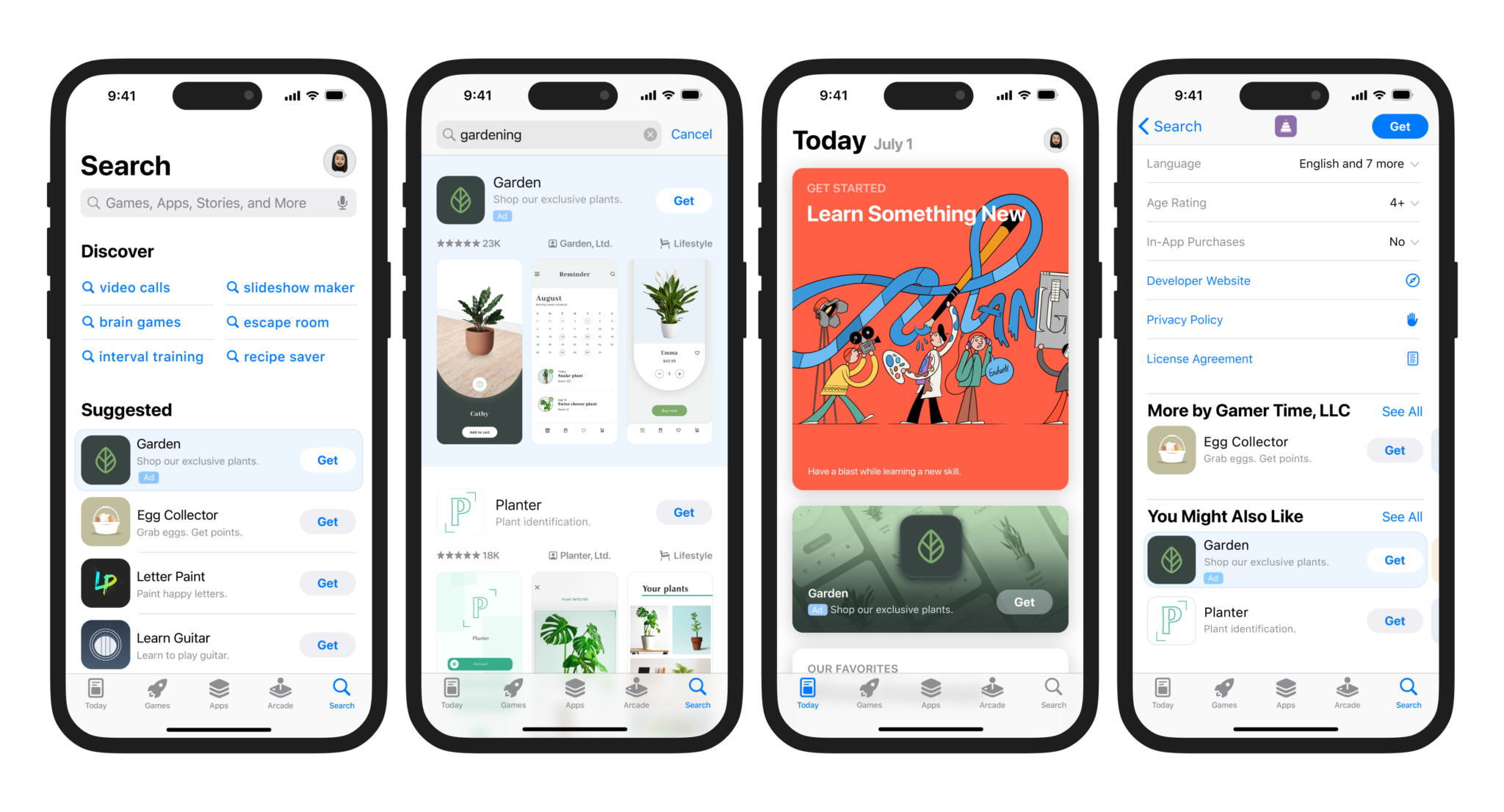
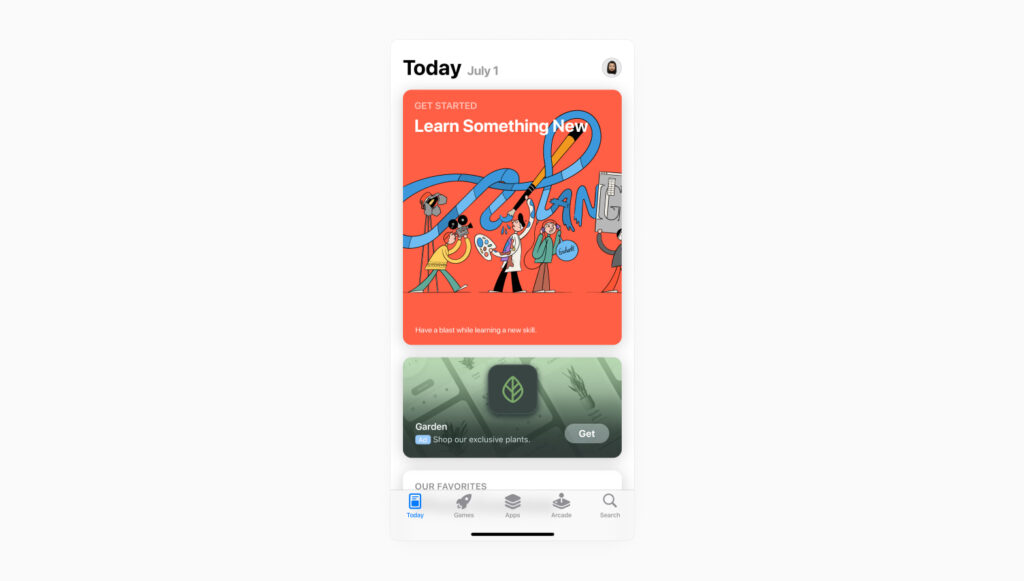
Today tab ads appear on the front page of the App Store, greeting all users who open the app. Globally, the Today tab is viewed by over 650 million users weekly, so this placement has the highest potential for generating impressions and brand awareness. Its creatives originate from a designated custom product page, which serves as its destination. Your custom product page can also contain a deep link that will direct users to a particular place in your app upon opening it (deep links are available on devices running iOS 18 and later.)
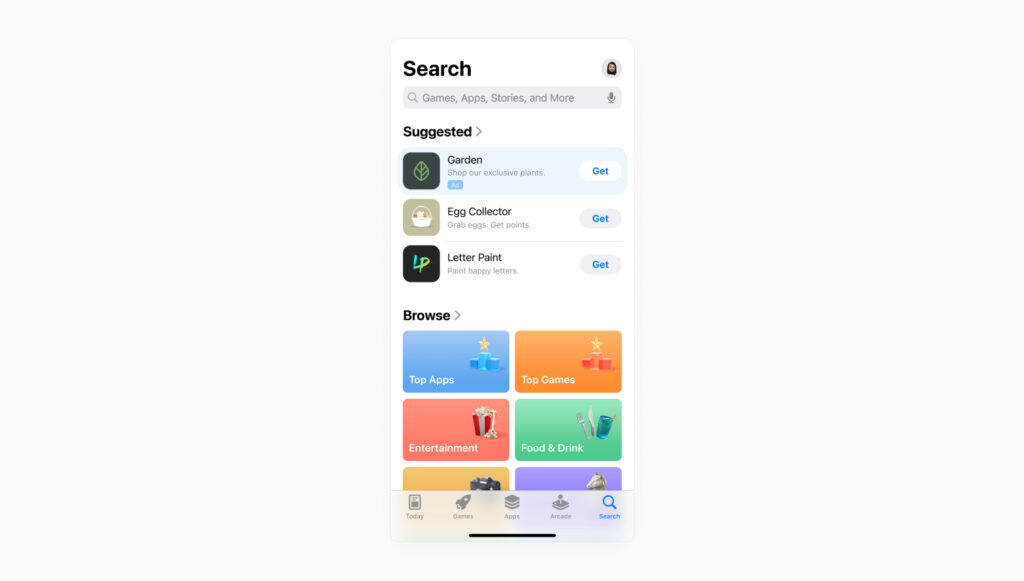
Search tab ads appear on the Search tab in the “Suggested” section at the top of the list before a user initiates a search. Over 70% of App Store users use the search feature to discover new apps, so search tab ads have tremendous potential for impression and awareness generation. Unlike Today tab ads, they lead to the default app’s product page, making them instantly implementable.
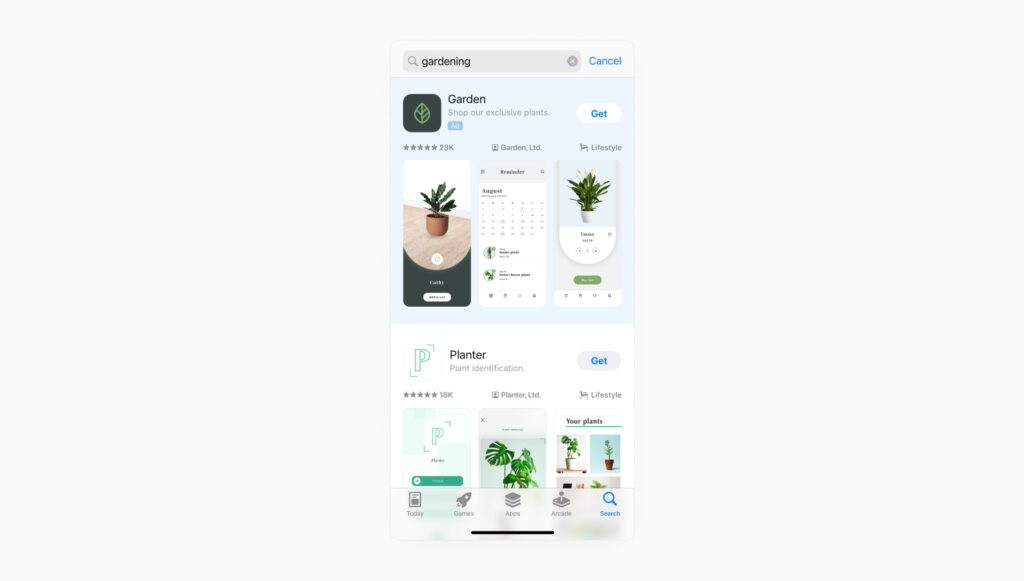
Search results ads are the first ad placement introduced historically and are the most commonly used, with the highest investment levels. Search results ads reach a highly motivated audience. This is reflected in their average key performance indicators (KPIs), like tap-through and conversion rates, which are visible in our campaign data published for benchmarking purposes. The primary purpose of search results ads is effective user acquisition.
Over 60% of app downloads occur after a search, highlighting the placement’s key role in finalizing the user journey. Search results ads can lead to the default app’s product page and custom product pages through ad variations.
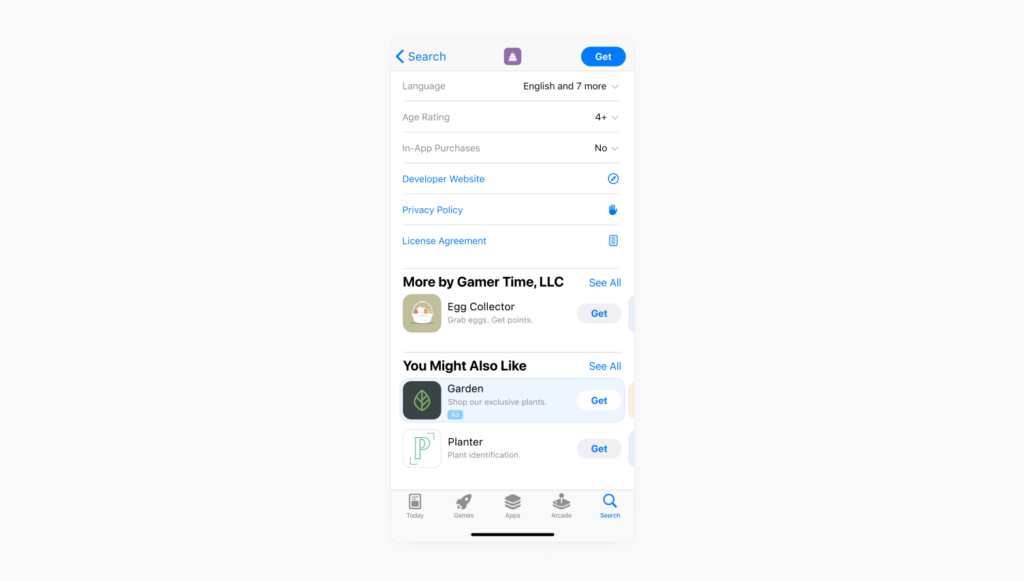
Product page ads appear on the product pages of similar apps. Advertisers can run ads across multiple app categories or refine the categories in which they appear, targeting users engaged in browsing and exploration. This flexibility allows multiple approaches to capturing their attention. Consequently, product page ads can be used for additional user acquisition.
There are three main benefits to implementing a multi-placement ad strategy in Apple Ads.
Increased visibility means more downloads. Each ad placement will be able to deliver both new downloads and redownloads, offering additional growth opportunities.
| LTV ($) | 0D | 1D | 7D | 14D | 30D | 45D | 60D |
| iOS | 0.3937 | 0.4447 | 0.6065 | 1.24 | 2.23 | 2.68 | 3.17 |
| Android | 0.0086 | 0.0093 | 0.0112 | 0.0129 | 0.0129 | 0.0142 | 0.0162 |
Today tab ads and search tab ads target users in the early stages of app discovery. Product page ads are aimed at those considering various options. Search results ads frequently reach those looking for a particular app or game or something less specific, like theme or functionality. More frequent connections with the user throughout their app discovery journey build brand awareness and contribute positively to the overall performance.

The “halo” effect of multi-placement ad strategy in Apple Ads campaigns means that each placement can perform better in unison than separately, driving more downloads in the long run. Better overall performance may be observed in higher tap-through rates (TTR), conversion rates (CR), and brand campaign effectiveness.
How should you track and analyze the performance of Apple Ads campaigns that employ multiple or all placements to connect with users to see those benefits? There are some things to consider, and a proper measurement and analysis plan should be the first step in crafting your multi-placement ad strategy. Running more complex promotions creates connections at various stages of users’ journey through the funnel, requiring a more nuanced measurement and evaluation approach.
SplitMetrics has been tracking its campaign data to provide benchmarks for Apple Ads since 2018, not long after the platform’s creation. Initially focused on search results ads, we also covered product page ads and offered a glimpse into search tab ads. Our benchmarks dashboard provides live data and includes search results ads and Search tab ads.
Given their different purpose and context, comparing benchmarks between the placements doesn’t make sense. As always, there are always several factors to consider when examining any performance data or averages:
Remember, each placement in Apple Ads connects with users at a different stage of their app download and engagement journey. This has a vast impact on their average metrics.
For example, a glance at the data from our benchmarks dashboard shows an interesting fact about Search tab ads. For the last six months, the average cost per mille (CPM) for search tab ads has been over thirteen times lower than for search results ads. This shows just how many impressions your app can get from this placement.
In Apple Ads, you pay only for taps, regardless of impressions.
Monitor your campaigns on the app level to evaluate the effectiveness of your multi-placement strategy. Their actual impact might not be visible on an individual level. Capitalizing on their positive halo effect may require additional actions on your side. Start expanding your keywords after launching additional ads, and pay close attention to the performance of your branded and generic keywords.
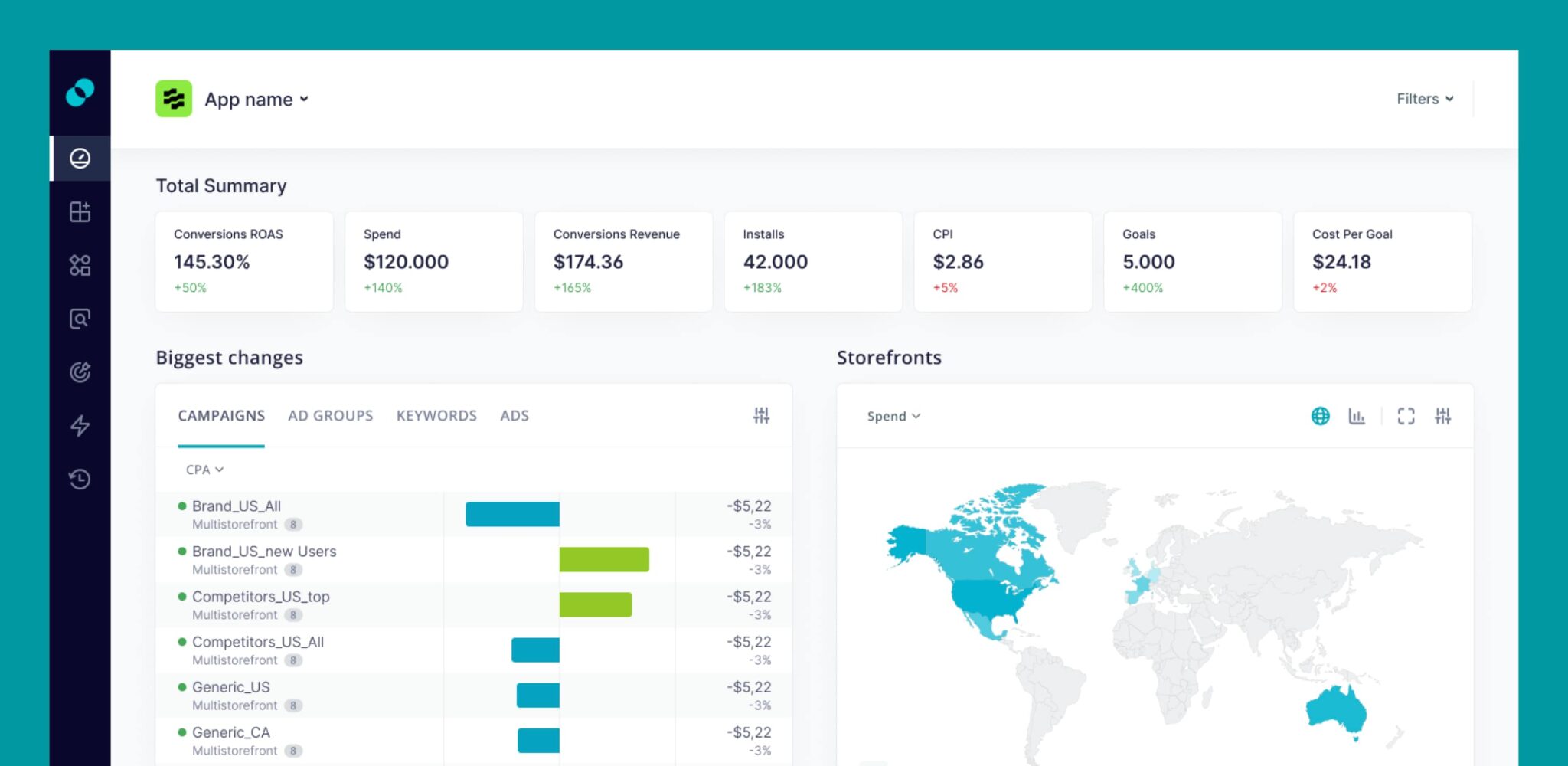
View-through metrics in Apple Ads may help you understand the impact of additional placements besides search results ads on your overall performance.
Installs (view-through): In Apple Ads Advanced reporting, the total number of new downloads and redownloads from users who viewed your ad but didn’t tap it within one day of the ad view. This metric includes new downloads (view-through) and redownloads (view-through). Source: Apple Ads.
View-through metrics track how many installations were influenced by ad impressions alone. Consequently, they may help understand the full impact of additional placements besides search results ads.
In today’s mobile environment, users often make decisions after some time. Conversion delay is a consideration for all placements. For example, it’s typically recommended to wait four weeks before pausing keywords and not delivering any downloads or goals (with the exact time dependent on the app’s business cycle).
Ads in additional placements should be given some time before evaluation. Today, user journeys through the App Store are more complex, similar to what we observe in browsers, webpages, and search engine marketing.
The algorithm determines how additional placements are displayed. To reach optimal efficiency, a warm-up period may also be needed. To see better results, you may need around four weeks to finish the learning phase.

How much you can benefit from a multi-placement ad strategy depends on various category-related factors and your competitor landscape. We recommend all beginners to Apple Ads start with search results ads and seek additional advantages with more placements depending on the situation and spending capabilities. Introducing more placement can help break the glass ceiling, provided search results ads are optimized with all diligence and app store optimization (ASO) is also at work. Consider the following scenarios when introducing other placements in Apple Ads.
Each app category on the App Store is unique in terms of search queries associated with them. For example, as evidenced by the case study of Locals, most searches in the Social Networking category are branded. Branded keywords are essential, with brand campaigns being a key source of user acquisition.
Still, significant ranges are built through expansive category campaigns, targeting many keywords related to themes or functionalities. What can be a perfectly viable strategy for a mobile game, enjoying a rich semantic base of keywords related to genre, subgenre, mechanics, and style, can be a serious challenge for an app from the Social Networking category.
The solution found was Apple Ads and ASO synergy that was reached through their alignment. In this situation, product page ads could redirect traffic directly from competitors’ product pages.
Many apps can be true powerhouses, with millions of downloads and high visibility. Some app categories are dominated by them, like Social Networking or Entertainment. Besides competitor campaigns, product page ads may be especially beneficial in such a case, allowing them to show their audiences that they offer related functionality.
Competitor campaigns are an essential part of Apple Ads campaigns. The free SplitMetrics Acquire Starter Plan offers a Brand Protection feature that allows you to spot competitor keywords that aren’t heavily bid on, improving user acquisition with this type of campaign. Product page ads are a logical extension of competitor campaigns, helping you redirect more high-intent traffic to your app’s product page and giving you an additional edge. Additionally, they may be a solution worth experimenting with when even advanced research shows competitors’ branded keywords are too expensive to target.
An impactful app launch can snowball into steady growth. It’s wise to take the most out of this period, as we believe that a high download velocity, in the beginning, can trigger organic ranking and is a key part of reaching an Apple Ads and ASO synergy. You can start pre-order campaigns and consider additional placements to give you many impressions quickly: Today tab ads and Search tab ads.
Search tab ads are a financially viable option for quickly increasing impressions. Remember, the majority of App Store users visit the Search tab routinely.
A multi-placement ad strategy can potentially give your app an edge over competitors. Besides being a source of new downloads, they may increase the effectiveness of your search results campaigns at an attractive cost compared to what you’d have to spend on pushing search results ads to their absolute limit for your app and category.
In the context of scenarios in which including additional placements may be especially beneficial, crafting and implementing a multi-placement ad strategy in Apple Ads requires that some things are in place.
ASO is the backbone of any successful App Store app growth, including Apple Ads, which greatly benefit from App Store optimization (and vice versa). Search tab ads and product page ads lead to your app’s default page, and the role of an engaging app icon, name, and promotional text can’t be exaggerated. Examine keywords you rank for organically and observe how well the algorithm understands your app. It may matter, especially for product page ads.
Researching your app category and direct competitors is the first step in evaluating how much a multi-placement ad strategy can benefit you. In the context of our checklist, you need to understand the following:
Answering these questions will help you fit your app in the scenarios described above.
The free SplitMetrics Acquire Starter Plan offers extensive keyword research capabilities. Brand Protection helps you evaluate branded keywords, and Keyword Discovery helps you assess your app category’s overall keyword pool.
The more you know, the more probable you are to make adding additional ad placements in Apple Ads profitable.
App Radar offers excellent features for holistic category evaluation: Metadata Benchmarks, an App Timeline, and freshly updated Keyword Research to help you understand your organic rankings and traffic.
Custom product pages allow you to introduce ad variations into search results, displaying tailored experiences for users looking for specific features. Today tab ads require a custom product page, both as a source of creatives and a destination. Experience with this feature might help you make the most out of this placement. Today tab ads target users with a different mindset and expectations than search results ads. Today tab ads can deliver confirmed results (like ty MY.GAMES case study, for example) but deserve special attention because of their unique properties.
Typically, we recommend targeting all users with Apple Ads, because of the significant percentage of users who don’t allow personalized ads while browsing the App Store. However, some options are still worth considering:
These are worth experimenting with additional placements.
Product page ad targeting can be refined with the following settings:
– All categories: Show your ad across all relevant categories.
– Specific categories: Show your ad in specific categories, including your app’s category or others.
– Other categories: Show your ad in app categories besides yours.
Apple Ads automation is available in the free SplitMetrics Acquire Starter Plan and is key to maintaining efficient, data-driven management that helps keep costs under control. Our platform allows you to automate nearly all Apple Ads management and optimization activities. Actions are immediate and precise, continuously operating within the KPIs you define for them. You can automate bid management of additional placements just like you’d do for search results ads. We highly recommend enabling rules for increasing/decreasing default max bids of ad groups of such placements.
Rule example: Increase default max bid on ads with too few impressions.
Action: Change default max bid / Increase by 5-10%
Conditions: Impressions (past 7 days) < 500
Rule example: Increase default max bid on ads with promising results.
Action: Change default max bid / Increase by 10-15%
Conditions: Goals (previous 14 days) > 0, Cost per subscription (previous 14 days) < t-CPA – 5% tolerance window OR (if there are not enough subscriptions): Installs (previous 3 days) > 1 CPI (previous 3 days) < target CPI
Apply these rules to ad groups in specific, selected campaigns or on the campaign level if you’re not using multiple ad groups within them.
Assigning the proper daily budget to new ad placements may require some experimentation grounded in their performance. This can be handled by automation rules, too.
Rule example: Increase Daily Budget based on performance
Action: Increase Daily Budget / Increase by 10%
Conditions: Spend (previous day) > 0.8-2 Daily Budget / Subscriptions (previous 14 days) > 0 Cost per subscription (previous 14 days) < target CPA – 5% tolerance window
This rule should be created for selected campaigns, as the daily budget is defined at the campaign level in Apple Ads. You can specify an upper limit never to cross a certain threshold.
The free SplitMetrics Acquire Starter Plan offers easy automation templates and many parameters to create elaborate rules, making your optimization immediate and fully data-driven. All with just a couple of clicks.
We encourage you to follow our Apple Ads optimization guidelines regarding when to raise or lower bids. The best course of action is to have a defined plan beforehand regarding acceptable CPA or the number of goals delivered.
In principle, a multi-placement ad strategy in Apple Ads involves all placements, as the assumption is that visibility at all stages of the user journey may translate into synergistic performance improvement.
However, to maximize effectiveness, consider tailoring your strategy based on your business scale and goals. It might make more sense to leverage all placements from the start for a major launch by a well-established brand.
On the other hand, small and medium-sized businesses may benefit from a more cautious, step-by-step approach. In such a case:
These two placements can be introduced quickly and efficiently as additional support for search results ads.
We highly recommend reading the following articles, which might push you to more experiments and better Apple Ads campaigns:
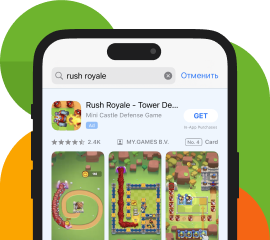

The multi-placement ad strategy in Apple Ads can give your app an edge for users’ attention. While not frequently utilized by beginners, it’s a viable way for experts in Apple Ads to seek additional ways of app growth. However, there are multiple scenarios where additional ad placements can help any app overcome various challenges and ultimately succeed.
